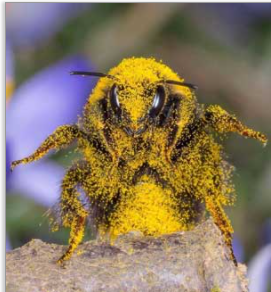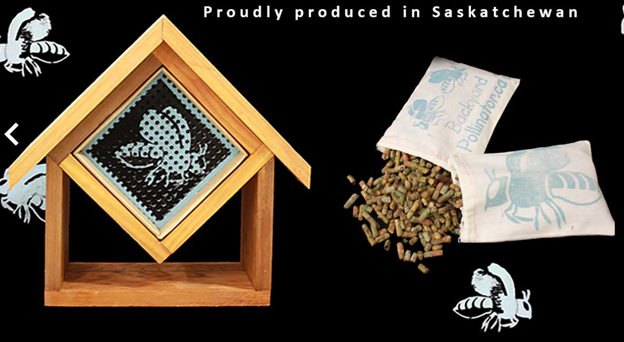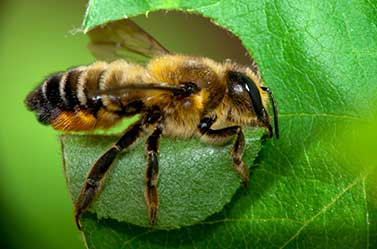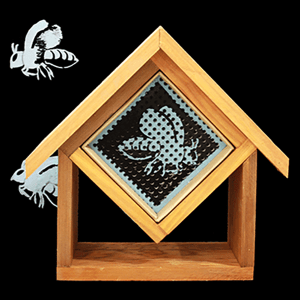- Canada’s Growing Zones Are Changing 2024 - January 12, 2024
- Attracting Wildlife To The Garden - May 16, 2023
- How To Garden Near A Septic Tank - May 9, 2023
Increasing yields in the garden is key if we are wanting to get the best results out of our tiny patch of paradise. With pollinators disappearing at rapid rate the use of leaf cutter bees in the garden is the perfect alternative. Leaf cutter bees do a better job at pollinating then honey bees and are easier to care for. Leaf cutter bees are also known as friendly child safe alternatives. In this blog we are going to look at exactly what it takes to keep leaf cutter bees in a backyard garden.
As Canadian gardeners we are always looking for ways to increase our yield in the garden. Leaf cutter bees for gardeners in Canada maybe the answer! The ways in which we can do this is through planting more plants, fertilizing the plants specific to their needs, and increasing the number of pollinators in our garden with colors. We spoke about this a little bit in our blog post about increasing butterflies and hummingbirds in our garden be sure to check this out.
However, it is important to note that this may not always work in some cases and actually introducing pollinators to the garden maybe the next best thing. One of the simplest critters to add is the leaf cutter bee. Leaf cutter bees are much simpler to care for then a honeybee hive.
In this blog post we will be going over:
- Exactly what lease leaf cutter bees are
- How to get leaf cutter bees introduced into the garden.
- Why leaf cutter bees are considered super pollinators
- How to go about caring for them
- How to close down the season.

Friendly Pollinators
Something important to note about the leaf cutter bee is that they are not aggressive. That means they are both pet and child safe. They do not aggressively protect their nest. And they will not react if gently nudged on a flower or other platforms. You can actually look up videos online of people petting the leaf cutter bees and not being stung.
Leaf cutter beekeepers actually will not wear any protective equipment when dealing with the nesting box. This is because of their docile nature and their dedication to get work done. This also means we can place the nesting block close to a sitting area so you can enjoy and watch the bees at work. The only thing you do not want to do is put it you are in a high traffic area because this will scare the docile critters.
History of The Leaf Cutter Bee
Leaf cutter bees were discovered in the 1930s during World War II. Soldiers from North America (Canada and the US) noticed alfalfa fields in Europe covered with these little flighted critters. They also noticed that the alfalfa fields invaded by leaf cutter bees generally yielded higher harvest and ultimately a better crop. This influenced North American farmers to bring the bees back to Canada and the USA.
Are Leaf Cutter Bees Invasive To Canada?
Yes, that does mean the leaf cutter bees are invasive species. However, if you did not know honeybees are also considered invasive species in North America. Honeybees were brought over around the same time as the cutter bees. The good news about this invasive species is that it does not affect the normal functions of native plants or insects in North America. That would mean it is a beneficial addition to the North American ecosystems.
Leaf Cutter Bees In Cold Climates?
In colder climates such as in Canada and some of the lower zones in the United States the bees are unable to survive the winter. Any zones they get below +5°C will kill dormant leaf cutters. This means if you choose not to overwinter your bees in a cool basement or refrigerator they will pass away outdoors. We will get into this topic just a little bit later.

Leaf Cutter Bees Pollinate Better Then Honeybees
The USDA has done a number of studies in this topic ranging from greenhouse control studies to netted outdoor studies. The results from the studies are staggering. It has been shown that one leaf cutter bee typically will do the job for approximately 20 honeybees.
I know I am also gob smacked by that data. This is what we consider a super pollinator.
What Is A Super Pollinator?
A super pollinator is considered essentially a effective pollinator. Any bug or animal that is able to carry a large amount of pollen flower to flower is considered a super pollinator.
Honeybees Vs. Leaf Cutter Bees
Honeybees typically carry pollen on just their hind legs. You can see this in photos when we look at honeybees in nature. Super pollinators are able to carry pollen all over their body. This results in higher yields because the bug is carrying a larger volume of pollen. This means there is a great chance of pollination for a wide range of genetic code.
Wild Bees Vs. Leaf Cutter Bees
Interestingly enough wild bees in North America are generally considered super pollinators. Most wild bees that are native to the area have the ability to cover their entire bodies in pollen. This makes wild bees a Keystone species in our ecosystem. While leafcutter bees may not be native to the area they do classify as super pollinator due to the excessive number of hairs that they have all over their body.
Out of the 4000 native species of bees in North America. Leafcutter bee species native to North America are considered super pollinators as well. However, the ones that you generally purchase, or you see in farming operations are imported from Europe. This is most likely due to the ease of starting nesting blocks in North America with already established species in Europe.
What Are Solitary Bees?
Leafcutter bees are considered solitaire bees. There are hundreds of different types of solitary bees in existence. the word solitary is a way to define their way of living but also their life cycle. Leafcutter bees live in nesting blocks and not in hives. Honeybees or bumble bees live in hives that contain honey.
Do Leaf Cutter Bee Produce Honey?
A nesting block does not contain honey. This is why leafcutter bees are known to be docile creatures, they do not have honey to protect. However, honeybees do produce honey and therefore need to protect it. Solitary bees are known to have short but busy life cycles. The main goal of a solitaire EB is to reproduce for the next generation. The effective pollination they are able to achieve is simply a byproduct of their life cycle.
Lifecycle of A Leaf Cutter Bee

A leafcutter bee life cycle is pretty simple it begins when the temperatures outdoors are above 25 degrees Celsius. The cocoon like leaf capsules slowly begin 2 bring new life into the world. When the bees first emerge, they can be a little dopey but don’t worry they will eventually warm up an get their bearing. The initial few weeks is mainly for reproductive value.
Male Leaf Cutter Bees
Male leafcutter bees only live as long as it takes to have children with the females. After the males have fulfilled their duty of procreating, they then die off. This leaves the rest of the season and all the hard work up to the female leafcutter bees. Female leafcutter bees are able to find homes, locate food, and hatch the new eggs.
Female Leaf Cutter Bees
A single female lead cutter be will they up to 20 baby bees within its lifetime. 1/3 of all 20 eggs is typically female. From start to finish of the life cycle it is anywhere from 6 to 8 weeks. That means if your growing season or warm days is over that time frame you may get two generations per summer. At the end of the year, you can bring the nesting block indoors and store it for the next summer.
Nesting Material
This is why leafcutter bees are called leafcutter bees. Their masking material is composed of leaf matter. There are two different types of cuts the female leafcutters will make when forming their tunnels for the nesting block.
The first type of cut is 1/2 circle type cut. This is what makes up the majority of the outside on the tunnel. The second type of cut is a flat peace that is used as the cap for the tunnel. Inside of each tunnel there is a Brown silk comfy coating that keeps them snuggled in through dormancy. If you decide to overwinter your leafcutter bees, you may want to bring the entire nesting block inside rather than trying to pick out the tunnels.

Again, with the nesting blocks there is no honey to deal with so there is no need to provide sugar water or any extra steps. This is really nice because with honeybees we actually have a lot of maintenance involved. You will want to store your nesting blocks at a temperature of five degrees Celsius to 15 degrees Celsius. Any lower than that temperature and they will not survive the winter period any higher than that temperature and they will try to continue on with their life cycles.
Planting Food Sources For Leaf Cutter Bees
If you choose to have leafcutter bees in your backyard you will want to provide them with food. The more food you provide the less distance the leafcutter bees will travel to find food. A typical day of travel would be approximately 100 meters, but they have been known to fly 200 to 300 meters away from the nesting block if necessary.
Any generic wildflower mix will satisfy a leafcutter bees hunger. Along with any sort of fruit or vegetable crop. It is important to note that if you are trying to keep leafcutter bees in a cool climate they will not be hatched and ready to pollinate fruit trees in the spring. Fruit trees typically flower in late May early June before they leafcutter bees have woken up from their winter rest.
Try Cover Crops For Your Soil & Bee Friends
Besides a wildflower mix and your classic vegetable or decorative Flowers in the backyard you may want to consider planting alfalfa. If you have watched any of my videos about cover cropping you will know the importance of using a nitrogen fixing crop in the Garden. Alfalfa is a nitrogen fixing crop that is able to take nitrogen from the air and secure it in the soil for plant uptake. Not only do they leave cutter bees enjoy the Flowers and the leaves for nesting material it will also benefit the plants in years to come.
Where to Place Your Leaf Cutter Bee Nesting Block
When looking for a place to put your nesting block you will want to take into consideration light and protection from the elements. Nesting box come in all different shapes and sizes from single cells to multiple cell homes. ultimately you will want to choose a nesting block that suits your backyard and the number of bees you would like buzzing in your backyard.
Viewing Spot
One thing to consider is how close you would like them to a viewing area. Backyard pollinators provides a nesting block that you were able to stick it to your window so you can enjoy leafcutter bees from the comfort of your home. However, if you get a nesting block that is a Hut that needs to be put on a steak then consider where you would want that to be relative to a seating spot in the yard. Half the fun of the docile friendly leafcutter bee is being able to observe the critter at work.

Shelter From Wind & Rain
Another factor you will want to take into consideration is shelter from high winds and rain. If you get a nesting block typically there will be a shelter of some sort. This will protect the bees from getting wet which is very important to their survival. If the nesting block does not come with a protective roof you may want to consider placing the nesting block under an eaves or any sheltered area where it will not get drenched.
Temperature & Sunlight
The last factor to take into consideration is temperature and sunlight. Leafcutter bees do like warmer temperatures, but they do not enjoy being cooked. A South facing wall is less than ideal when it comes to selecting a leafcutter nesting block position. They also do not like cooler temperatures and therefore a North facing wall is also less than ideal if it is heavily shaded. We are looking for a place in between where it gets some sunlight but also a little bit of shade. If you have designated an area of your yard as partly shaded this would be the area that your nesting block would do best.
Where do you buy leaf cutter bees in Canada? Where do you buy leaf cutter bees in the US?
If you are looking for a simple backyard setup you can go to one place to find a leaf cutter dealer. The company is called backyard pollinators. And you can click here to check out their website. If you are in the Canada region of the world you can actually get their nesting blocks and huts at peavey Mart or TSC stores.
Backyard pollen eaters are kind enough to store your leafcutter tunnels until it is time to place them outdoors. Their shipping times range anywhere from February to June. if you are interested in keeping leafcutter bees this summer but do not want to store them in your fridge, I advise requesting them to be shipped sometime in June. However, if you are excited about your leafcutter bees and you want to set something up in the backyard prior to the tunnels showing up you can grab their Hut.
I have a backyard pollinator hut and they are awesome quality. They are well built and will be the official home for my leaf cutter population for years to come. You can also get a backyard pollinator hut that is not assembled that you can assemble on your own.
Conclusion
I hope this guide was able to convince you to get leafcutter bees for your backyard. If you are looking for higher yields without the hassle of a honey beehive then this is the critter for you. They are pet and child friendly due to their non-aggressive nature. And they conveniently are clean and easy to care for.
While they are not native to North America, they are beneficial to North American ecosystems. If you choose to bring them into your backyard keep in mind it is unlikely that they will survive any winter that gets below 5 degrees Celsius. This means you may have to overwinter them indoors in a fridge or garage. However, if you choose to only keep them for one year you can very easily repurchase gnu tunnels year after year from the backyard pollinators group.
Because leafcutter bees are known to do the job of up to 20 honeybees is important to provide them with wildflower mixes, alfalfa, and a large array of vegetable crops. Keep in mind that these bees do not like to travel more than 100 meters from home to collect all their pollen. Because they are a super pollinator, they will be pollinating your neighbors garden as well.
I hope you found this guide on leafcutter bees helpful if you did please let me know in the comments. Check out my YouTube video for more details and a closer look at the backyard pollinators products. be sure to share this with anyone that you think would enjoy.